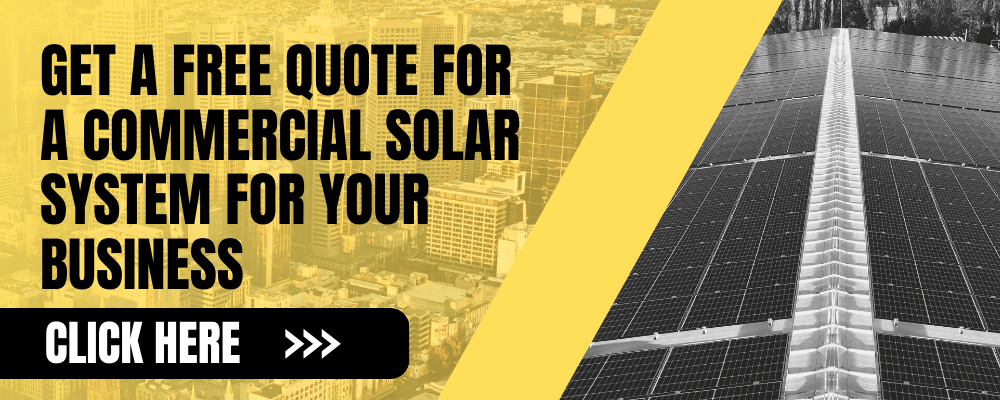
On this page
You may be familiar with residential solar, and might even have solar panels on your roof at home, but did you know that commercial solar can often require different components, extra planning and permits, and safeguards to protect the grid? Depending on the energy needs of your business, and the size of the system you plan to install, it may be necessary to engage a solar retailer who specialises in solar for commercial. That’s right – not all solar installers are the same! When seeking a commercial solar quote in Australia, choosing a provider with expertise in commercial-scale installations is important. This ensures you get a tailored solution that meets your business’ specific energy requirements and goals.
Commercial solar systems, including commercial solar panels, installations, and power systems, are designed to meet the energy requirements of businesses. These systems can vary in size and require specific components and planning. Let’s explore how commercial solar works and what you need to know during the planning, installation, and post-installation stages of your commercial system.
Energy Matters specialises in tailoring solutions to meet the unique energy demands of businesses. If you’re considering a commercial solar installation, our free solar quotes can offer valuable insights into the specifics of your project.
Energy Matters has been a leader in the renewable energy industry since 2005 and has helped over 40,000 Australian households in their journey to energy independence.
Let us discuss and choose the best quote that suits your needs and budget, and we can connect you with our trusted local installers, who will provide up to 3 FREE solar quotes for your home and business solar energy system.
Commercial solar panel system size differences
Just as every house is different and has different energy needs, so too are businesses. The size of the commercial solar system you need will be determined by your energy usage, but will also be constrained by the space available for the panels.
System sizes that are less than 30kW usually do not require any additional permits, planning, or components that would be necessary to employ a commercial solar specialist. As such, a residential solar installer could be employed to install such systems.
There are 3 main brackets, that we classify as ‘small’, ‘medium’, and ‘large’, for commercial solar.
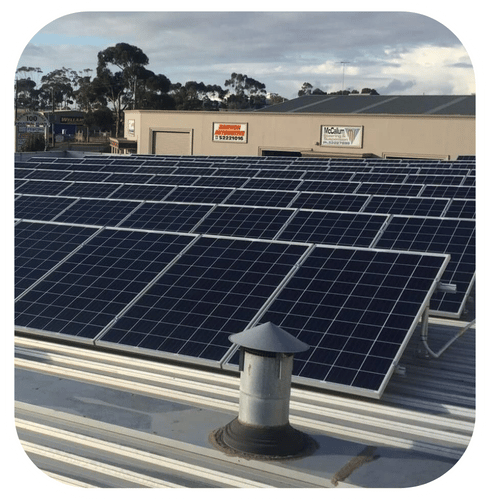
30 – 100kW
‘Small’
Commercial solar panels this size are usually placed on buildings that can accommodate approximately 100 to 400 panels. You might find a system this size on your local bowls club roof, or a small retail building.
Your installer will need permission granted from your local DNSP to connect the system to the grid. We highly recommend that you engage a commercial solar installer to plan and deliver such a system.
As these systems are less than 100kW, they are eligible for STCs. You can expect a point-of-sale discount from your installer.
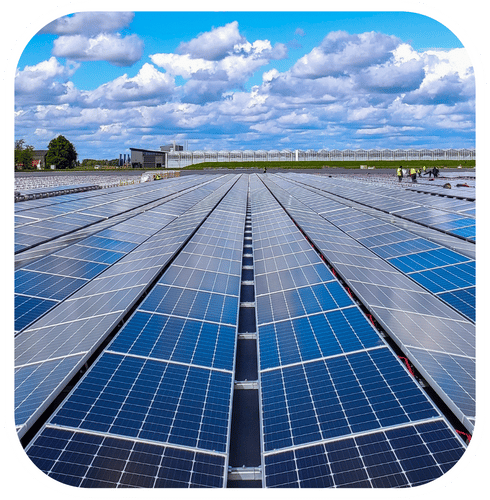
100 – 250kW
‘Medium’
Mid-range commercial solar systems of this size require a commercial solar specialist to plan and install. Much the same as a ‘small’ commercial system, applications are required to ensure that you can connect to the grid and safely export excess electricity.
Medium-sized systems are no longer eligible for STCs. Instead, LGCs are generated and can be claimed each year. This means that there is no point-of-sale discount applied to such sized systems.
Due to the larger scale of these systems, and the need for 400 to 750 panels, you are likely to find such systems on factories and large business buildings.
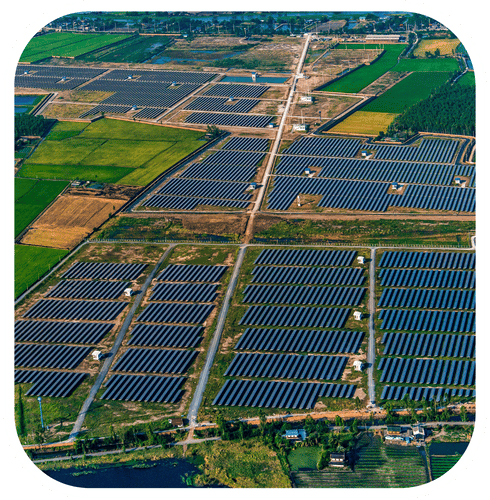
250kW +
‘Large’
The sheer size and space required for panels for a system this size necessitates the need for a specialist commercial installer.
You will find systems this size on large factories (usually shared over the roof space of many factories), shopping centres, and, of course, solar farms.
A great deal of planning, permit application, engineering, and paperwork goes into commercial systems of over 250kW.
Commercial solar panel system components
The components you select for your system will not only determine the cost but also the overall number of panels required PLUS the quality and life expectancy of the system. Commercial-grade inverters are also required for your commercial solar system.
Solar panel size - it matters
Solar panels come in different sizes, outputs, materials, and colours. Your typical residential solar panel has an output of 370 to 440 Watts. Commercial solar panels typically range from 450 to 600 Watts.
The difference in wattage results in fewer panels required and less real estate needed on your business’s roof. Your panels will also have a higher overall efficiency rating, resulting in more power generation.
Higher-wattage panels are also synonymous with quality brands. Quality brands mean that your system is not only more likely to last longer, with higher efficiency over the lifespan of the product, but the manufacturer is likely to be around for any warranty claims.
Our recommended Commercial Solar Panel brands are SunPower, REC Solar and Longi.
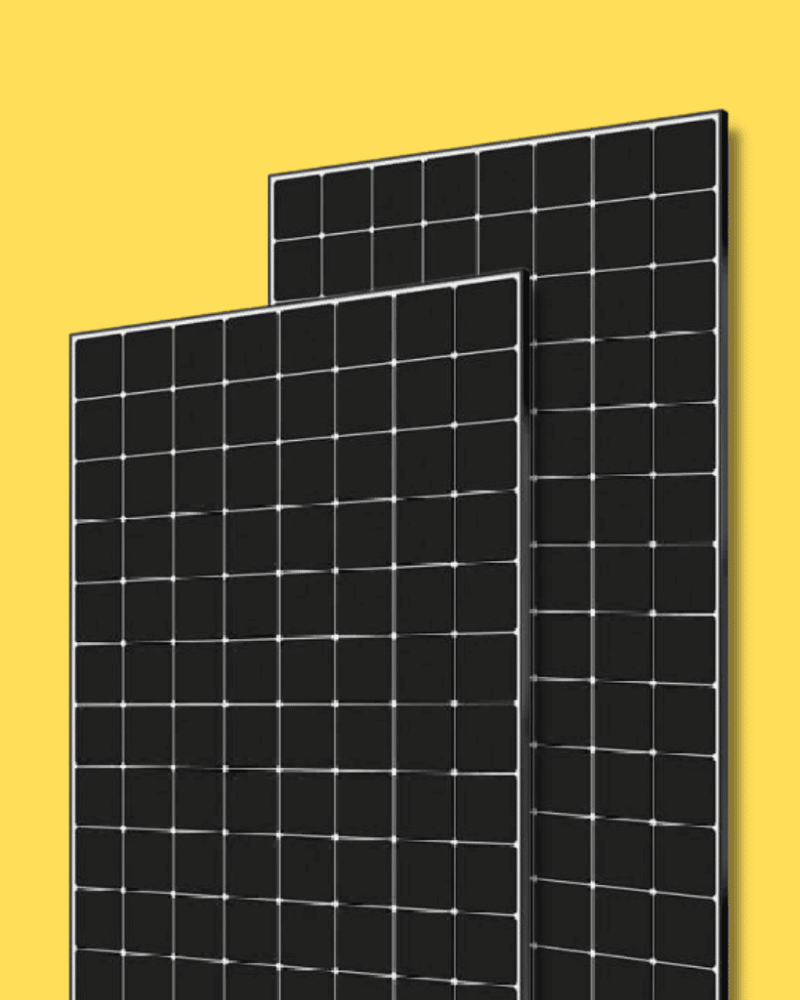
The right inverter for your commercial solar panel system
Commercial solar PV systems require commercial-sized inverters. Depending on your total system size, you may need more than one inverter.
String inverters - the most common inverter
Unlike a residential inverter that has, typically, 2 strings, your commercial solar panel system might require an inverter with multiple strings, or multiple inverters with multiple strings to each one. Your system may be designed so that you have one centralised, often very large inverter, or multiple smaller inverters. Should you select the latter, you will provide your system with a safeguard should one of the inverters shut down. A centralised system, with one large inverter, provides no back up should the system fail.
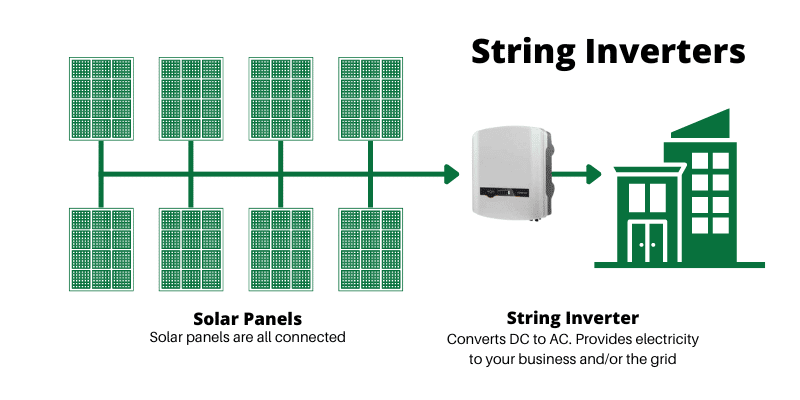
Commercial string inverters vary on how many strings they have depending on the size and the brand. A 75kW GoodWe inverter, for example, has 10 strings. String inverters are subject to shading and, therefore, the lowered efficiency or shutting down of a whole string. If one panel is shaded, then all of the panels on that string will perform to the same lowered output as that one panel. This is where power optimisers and microinverters step in.
Power optimisers for commercial solar panel systems
To counter the shading issues often found with string inverters, power optimisers work to ensure that a string of panels remains functioning and producing power.
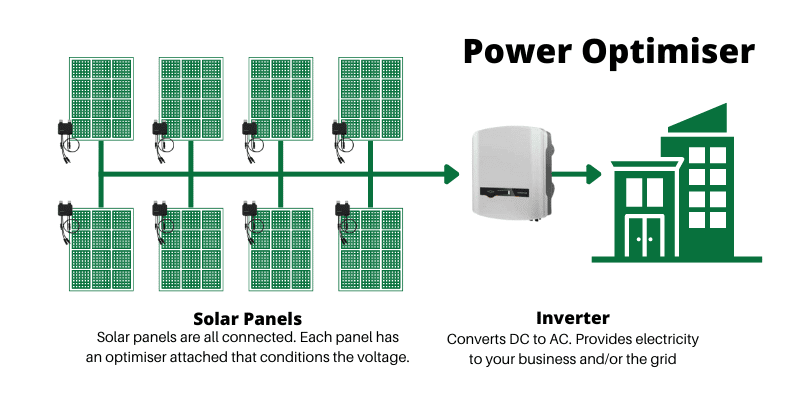
Roofs typically have some shading due to air conditioning units, ventilation pipes, parapets, trees, and nearby buildings. Without a power optimiser, shade on just a portion of one panel will result in lowered output for all the panels attached to that string. Bird poop and debris can also have the same effect and can also result in the whole string not functioning at all.
For example, if all the panels attached to one string are rated at 300W, and one of the panels is producing 250W due to shading, ALL of the panels on the string will produce only 250W. the weakest link brings down the output for all.
Power optimisers condition the DC power and send it to the inverter. It allows the weakest link panel to provide its lowered output to the rest of the string. This means that the rest of the panels will continue to provide their maximum output and the panel with the shading will provide its lowered power.
Power optimisers are a cost-effective solution that is utilised by many businesses across Australia. Something to keep in mind is that optimisers are not required for every single panel. Your installer will be able to identify the panels most at risk of shade and have the optimisers installed to best ensure that your system is as efficient as it can possibly be.
If you expect varying degrees of shading across your system then microinverters may be another option to consider.
Microinverters for commercial solar panel systems
Similar to power optimisers, microinverters ensure that any weak link does not inhibit the efficiency and energy production of the rest of the panels. But unlike power optimisers, microinverters operate individually and do not require a central inverter.
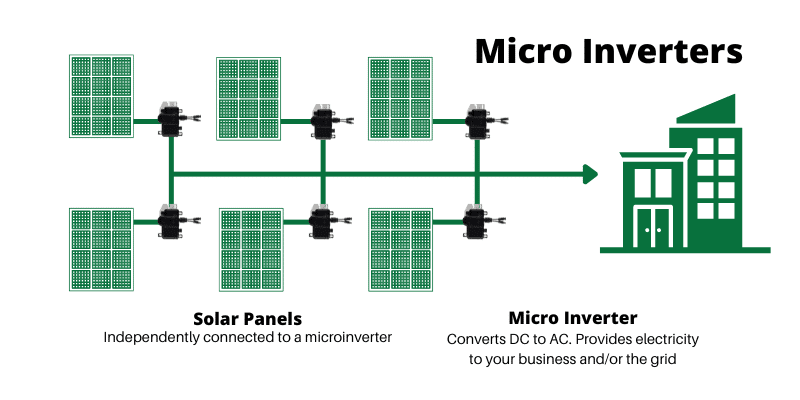
A more expensive solution for shading, microinverters work as the name suggests. Each panel is fitted with a microinverter which converts the DC current to AC. If one panel fails, there is no impact on the rest of the system.
As these are mini inverters, they usually bring the total cost of a solar PV system to around 20% more than an equivalent string system.
For this reason, microinverters are seldom utilised for commercial systems.
If you are in the market for microinverters, we highly recommend Enphase as your microinverter manufacturer of choice.
What commercial inverter should I choose?
Choosing the inverter that best suits your needs is no easy task – and this is where your solar installer steps in to design a system with the best panels and inverter for your current and future needs.
Your installer will take into account your energy needs, the panel requirements and layout, battery storage (where applicable), the system location, and the cost.
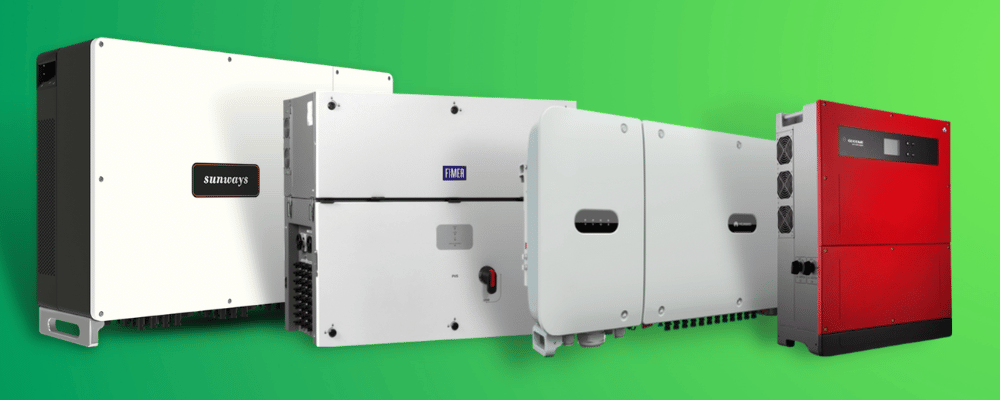
Should my business invest in a battery storage system?
This is an often-asked question across the board – whether you are looking for battery backup for the home or your business. There are a number of areas to consider when assessing if battery storage is suitable and viable for your business.
What are your core hours of operation?
A business that operates solely from 9 to 5 is unlikely to ever require battery backup. If you are consuming all of the energy your solar system is producing then there will be no excess energy to store.
Does your business use a lot of electricity at night?
Do you have refrigerators or freezers that consume energy 24/7? Are you a sporting club that runs stadium-style lights for nighttime games? Maybe you run a hotel that has guests that use most of the electricity when the sun goes down?
If your business uses a considerable amount of energy at night, then battery storage may be beneficial.
What size solar PV system will you be installing?
Your commercial solar installer will assess your current and future needs and design a system that will suit your budget, address your energy needs, and work within the constraints of your roof space.
If your budget and roof allow for it, and you wish to add battery storage, then sizing up will allow for excess energy to be generated and stored for use at night or on cloudy days.
The bottom line
Battery storage is not cheap and should be carefully considered to see if it will benefit your business. Batteries can usually be added to an existing system, so if it is something you wish to consider in the future then there is no need to have a battery installed at the same time as your commercial system.
We recommend discussing battery storage with your commercial solar installer in Brisbane and checking out our dedicated page on commercial battery storage.
Understanding limitations, permits, and agreements
Even if your system is 100% off-grid, your business will still need to seek various approvals and permits from relevant local and, sometimes, state authorities.
Whether on-grid or off-grid, most commercial solar systems require council approval. In addition to this, grid-connected systems require approval from the local DNSP (Distributed Network Service Provider). The DNSP may provide conditions and limitations due to the grid capacity and infrastructure.
If a limitation is placed on your system, you may need to have an export-limiting device installed on your system. This device ensures that the local infrastructure is not overwhelmed by electricity exported to the grid. An overloaded transformer is not only incredibly dangerous but poses a risk to your energy security, as well as your neighbours.
We suggest that you ask your installer to get the required approvals and permits in writing.
While a limiter will reduce the amount of electricity you can export to the grid, this should have minimal impact on your energy bills. If your business operates during daylight hours, then you are likely to be consuming most, if not all of the energy being produced.
Rental property agreements and commercial solar
If your business rents the property where your business is located, you may be wondering how a commercial solar system can be installed and by whom it is paid.
Unlike residential rentals, which are often 12-month lease agreements, commercial properties are often leased for 5 or more years. Some commercial properties already have solar installed, so the tenant can start saving immediately. But, for the majority of commercial rental properties, the building is solar-less.
Permission from the landlord must be sought and an agreement must be made on:
- Who will pay for the system
- Who will receive the FiT credit
- Terms of the installation – changes to the rental agreement and leasing term
- Who will be responsible for the LGCs and any financial benefit thereof
There’s a lot to consider but the agreement can be beneficial to both parties. Should you agree to split the costs and the benefits, the system might end up being more financially beneficial than if you were to purchase the system yourself.
Commercial solar rebates, grants, and incentives
Solar PV systems of any and all sizes attract generous incentives from the Australian federal government. A system less than 100kW will be eligible for Small-scale Technology Certificates (STCs). Systems over 100kW will be able to generate Large-scale Generation Certificates (LGCs). Both of these incentives provide a means to reduce the cost of your system.
In addition to the federal incentive, each system is eligible to receive a Feed-in Tariff (FiT) for electricity exported to the grid.
For more information, and to see if your state has additional incentives, grants or rebates, head to our Commercial solar rebates, grants and incentives page.
Commercial solar PV system design
Did you know that the average commercial solar panel weighs 22kg?
An average residential 6kW solar system can expect a loading of approximately 360kg on the roof. Can you imagine the weight of a 100kW system?!

Structural engineers are employed to ensure that the roof of your business can safely and securely withstand the weight of a commercial solar system. Ensure that the commercial solar installer you choose has the engineering expertise and credentials to inspect the site thoroughly.
If your business’s roof is not acceptable for mounting, you may wish to consider a ground mounted system. Not only will you need the land and space for such a system, but you can expect a much higher cost.
Maintenance of your commercial solar system
While a solar PV system is considered low-maintenance due to its lack of moving parts, keeping your panels free of debris, and your inverter serviced, will ensure that your system performs at its best for years.
We recommend that you employ the services of a professional solar panel cleaner at least twice a year to clean the panels and remove any objects or hazards that might pose a fire risk.

Your commercial solar installer will recommend a servicing schedule that best suits the inverter and its warranty requirements.
Utilising your system’s monitoring platforms will ensure that you notice any fluctuations in the efficiency and output of your system. The fluctuations might be a sign that your system requires maintenance or servicing.
How long will it take to see a return on investment?
While some businesses install solar for the environmental benefits alone, most businesses are looking at the bottom line when considering if solar is the best choice for the organisation. The return on investment (ROI) is one way to measure whether the system will be worth the expense.
The good news is that most 30-100kW commercial solar systems installed in Australia can expect an ROI in 5 years!
Consider that the average lifespan of a solar PV system is 25 years and you’ll see that solar is well worth the investment.
Your solar installer will provide a cost analysis and an expected ROI timeline.
For more information about financing options available for commercial solar PV systems, check out our page on rooftop leasing and PPA.
Choosing a commercial solar installer
It is important to choose a qualified commercial solar installer who has experience with large-scale solar projects. The installer you choose should be able to help you design a system that meets your specific needs and budget.
When choosing a commercial solar installer, be sure to ask about the following:
- The company’s experience with commercial solar projects.
- The company’s warranty and maintenance policies.
- The company’s financing options.
Commercial solar panel is a great way for businesses to save money on their energy bills and reduce their carbon footprint. However, it is important to understand the differences between commercial and residential solar systems before you get started. By choosing a qualified commercial solar installer and doing your research, you can ensure that you get a system that meets your needs and budget.
Monitoring your commercial solar panel performance
Once your commercial solar panel system is installed, ongoing performance monitoring is vital to ensure it operates efficiently and meets your energy needs. You can track energy production, consumption patterns, and system performance in real time though advanced monitoring systems. This will let you identify any issues early, such as drops in output due to shading or equipment malfunctions, and can help optimise your energy usage for maximum cost savings.
Regular maintenance is also vital. Scheduling periodic inspections can maintain optimal efficiency and extend the lifespan of your system. Clean solar panels are necessary for capturing sunlight effectively; dust, dirt, and debris can significantly reduce energy production. Some businesses choose to invest in automated cleaning systems to ensure their panels remain in peak condition.
Integrating battery storage can also boost the efficiency of your solar system’s efficiency by letting you store excess energy generated during the day for use during peak hours or nighttime. This reduces grid reliance and optimises savings on energy costs.
Going commercial solar
When installing commercial solar for a company, it is crucial to be informed of all types of federal government solar rebates, incentives and the many benefits these provide, as they may help Australian businesses become future-ready and sustainable for years to come.
Contact us today for up to 3 FREE quotations from commercial solar firms we’ve pre-qualified and vetted for their track record of delivering Australia’s best business solar systems.








